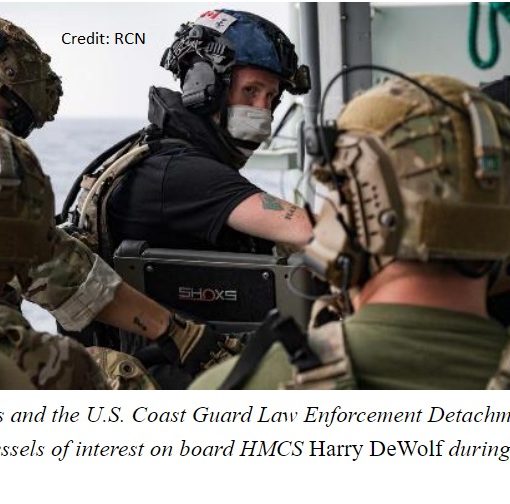(The conclusions, deductions and opinions expressed are those of the originator and are not to be construed as official policy of the Canadian Forces.)
The government believes that more emphasis on defence of our northern territory is essential, including (as stated in their last election platform's defence policy) the acquisition of "three heavy, armed icebreakers for the Navy." Such initiatives for defence and national sovereignty are welcome and long overdue, but such specialized vessels would not be a good fit for the Canadian Navy - the Coast Guard (CG) operates our current unarmed icebreakers and has accumulated world-class expertise in doing so. However, CG vessels do not make good defence assets: they are very slow, their unionized crews are not interested in performing paramilitary roles, and they have no experience with command & control or maintaining maritime domain awareness over the huge expanse of the Canadian Arctic.
There are alternate possible approaches: for example, a naval team could be embarked in CG icebreakers for specific missions, and I submit that future large CG icebreakers should be designed with space reserved so that command & control capabilities and basic sensor and weapon systems could be readily installed when needed and accommodation made available for appropriate naval personnel. When these compartments are not needed for defence purposes, I am sure that scientific teams and other groups could make good use of the space.
In more recent statements by both the Government and the Navy, it appears that naval-manned arctic patrol vessels will replace the previously announced icebreakers. Is there a role for such vessels in the Arctic, at least during the period when navigation is possible?
One need only look at Denmark's Thetis-class ice-strengthened vessels, which conduct patrols in Greenland waters, or Norwegian CG vessels capable of operations in their Arctic waters, to appreciate that there is a compromise between the extremes of icebreakers and thin-skinned frigates, to perform useful roles in the North.

Over the last half-century Canadian naval vessels have deployed into the Labrador Sea, Davis Strait, and Hudson Bay areas, but this has been during late summer when ice has retreated to its maximum extent. Surely it is not unreasonable to expect that Canada, with so much territory north of 60°, should be able to extend the navigation season of its patrol vessels beyond a month or two in the Arctic summer. Rather than start from square one to design a vessel that can do this, hopefully we would have the good sense to look at offshore designs that have already proved suitable for such a mission, and build them in this country. The Danish Navy's Thetis Class are excellent ships, designed to conduct patrols around Greenland, but I recommend that we look first at the recently completed Norwegian CG Arctic Patrol Vessel Svalbard.
Svalbard was completed in 2002 and is reinforced for operations in ice. At 6,300 tons full load displacement and dimensions of 340.3' x 62.7' x 21.3', this robust vessel has a maximum speed of 17.5 knots, and the long endurance (10,000 nm at 13 knots) essential for operations in the far North. She operates a medium (Lynx or NH-90) helicopter and is fitted for firefighting and counter-pollution work. As the Norwegian CG is a part of their navy, Svalbard is armed (1 Bofors 57-mm gun). Her cost is reported to be $90 Million (US), plus weapons and sensors - not expensive in comparison with a modern frigate. Svalbard has a complement of only 50 officers and sailors. Similar vessels in Canadian naval use could be manned with alternating crews in order to maximize operational availability.
If Canada is to operate such ships, there will be a need to gain further experience in Northern operations: this could be obtained through exchange programmes with certain NATO allies, and/or from our own Coast Guard. There are precedents with co-manning in government vessels, for example embarking RCMP in CG vessels or Fisheries Inspection officers in naval vessels. When the Navy operates Arctic Patrol Vessels, it would seem prudent to include one or more CG officers with ice navigation experience when operating in the far North - at least until more naval experience is gained.

During the months when Arctic waters are not navigable, by even the largest icebreakers, these very seaworthy vessels would be invaluable in performing offshore SAR and patrol missions off the coasts of British Columbia and the Atlantic provinces.
Various studies have indicated that the Northwest Passage will be open to conventional shipping for at least one month each summer by 2011, and the US Arctic Research Commission anticipates that the Passage will provide entirely ice free summer seasons by 2050. This trend raises important issues for Canada: I believe that naval-manned patrol vessels will be needed for sovereignty and security duties. Such vessels, as with our current fleet, will provide a national presence - in the case of the North, various legal opinions are on the side of that presence being necessary to back-up Canada's claim to this territory and its vast natural resources - and provide assistance to safety of navigation and respond to pollution control incidents in what will remain a very environmentally sensitive region.



